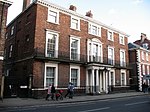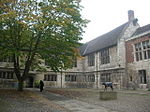Wandesford House

Wandesford House is an eighteenth-century almshouse in the centre of York, England, one of twelve still-functioning almshouses in the city, and the oldest still in its original building. Built in 1739 and opened in 1743, the house is an important example of the classical style in the city. Like many historic almshouses, it was referred to as a hospital before that term became chiefly associated with medical establishments. The almshouse lies a few yards outside the city walls on the north-west side of Bootham behind its front garden and between houses of later date. Inside are twelve flats intended for single Christian women, who are in hardship, need or distress, and over 50 years of age. Wandesford House is listed by Historic England as a Grade II* listed building and is owned and run by Mary Wandesford's Charity (the Wandesford Trust; charity reg. 251379). The archives of the Charity are held at the Borthwick Institute for Archives, University of York.
Excerpt from the Wikipedia article Wandesford House (License: CC BY-SA 3.0, Authors, Images).Wandesford House
Bootham, York Bishophill
Geographical coordinates (GPS) Address External links Nearby Places Show on map
Geographical coordinates (GPS)
| Latitude | Longitude |
|---|---|
| N 53.9639 ° | E -1.0866 ° |
Address
Bootham 37
YO30 7BL York, Bishophill
England, United Kingdom
Open on Google Maps










